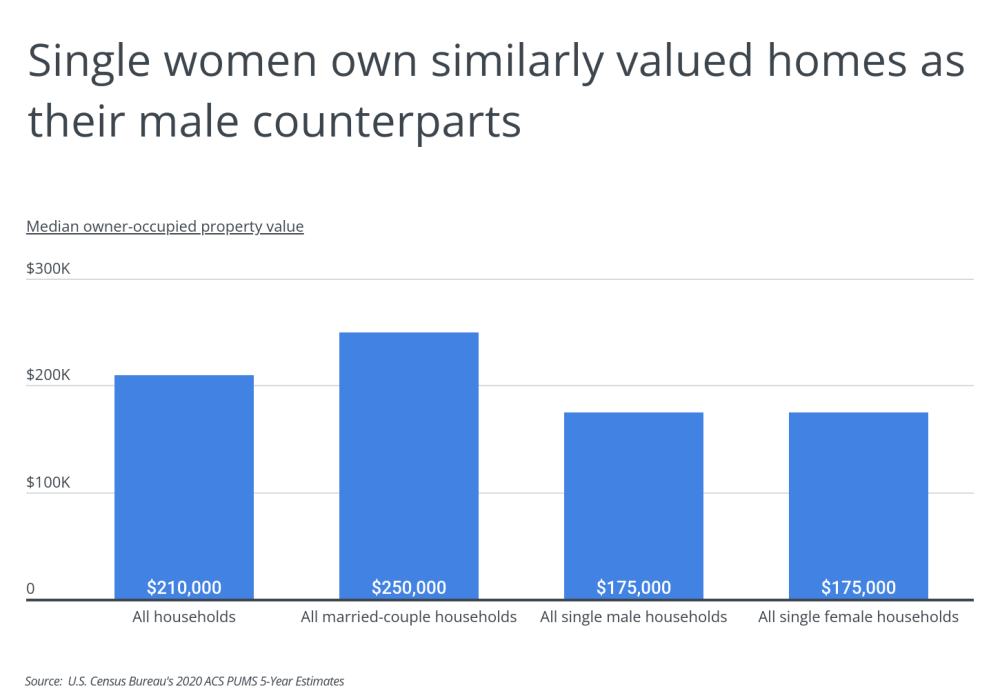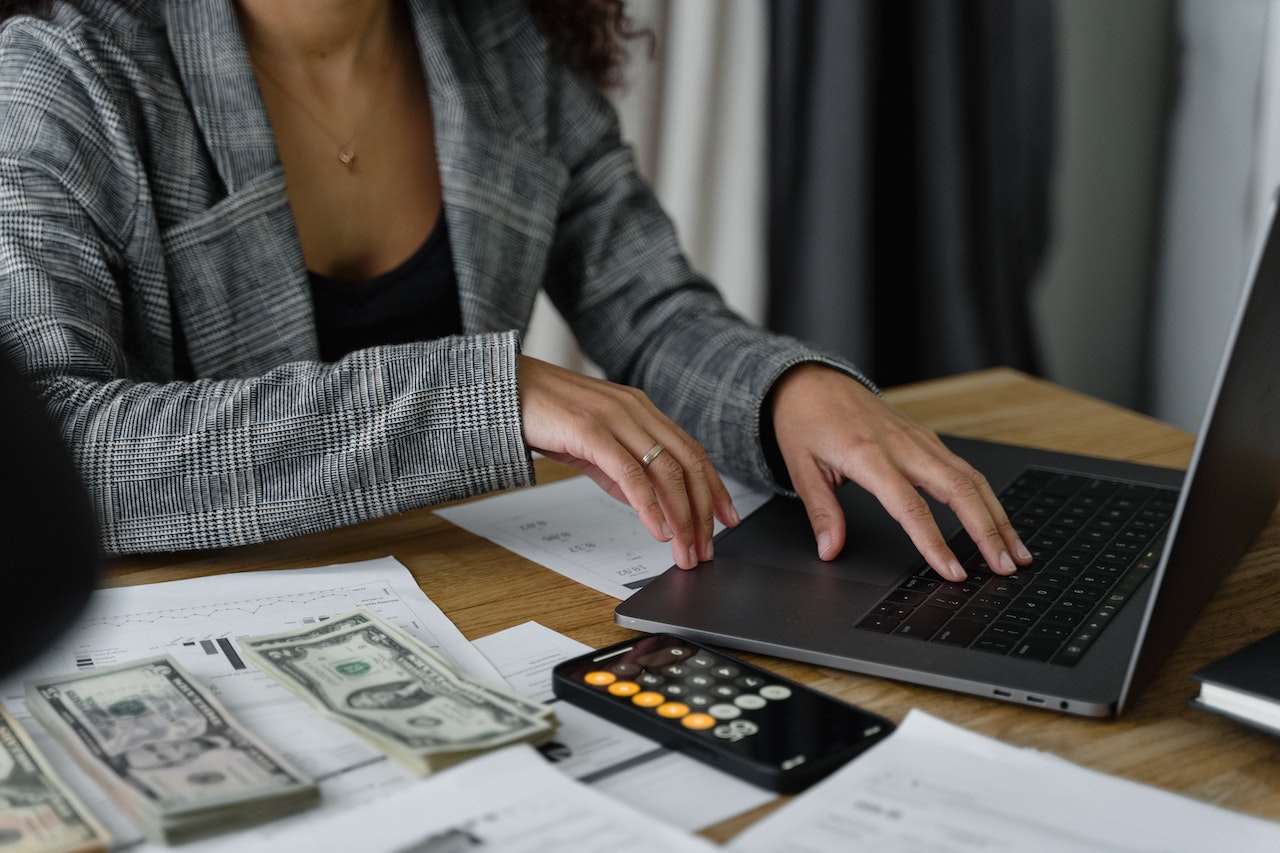Homeownership is a common goal for millions of Americans, but a number of social and economic factors can affect peoples’ ability to reach that milestone. From income to educational attainment to racial and ethnic background, there are significant gaps in homeownership rates between different demographic groups in the U.S. And family structure and gender are no different.
Married couples tend to have higher rates of homeownership and can afford more expensive homes due to combined financial resources. But for singles, the U.S. sees a gap between rates of homeownership by gender. In 2021, 55.1% of single females owned a home, compared to 48.6% of single males.

The percentage of single female homeowners has exceeded the share of single male homeowners dating back at least 45 years. More than half of single women have been homeowners in all but five years since 1976, while the homeownership rate for single men has never topped 50% in that time. Despite this, the gap has narrowed over time. The homeownership rate for single women was more than 15 percentage points higher than the rate for single men in the late 1970s, but today the gap is just 6.5 percentage points.
Women attain these higher rates of homeownership despite being on the unfavorable end of a different gender gap in compensation. Women in the U.S. earn around $0.84 for every $1 earned by men in the U.S. Like the homeownership gap, the gender compensation gap has closed slightly over time, but many women still face a number of factors that limit their earnings. These include differences in jobs and industries worked across genders, loss of time and experience in the workforce due to motherhood or other caretaking responsibilities, and the effects of bias and discrimination on women’s wages and working conditions.
In light of this financial disadvantage, women are more likely than men to make sacrifices when saving for a home. A recent study from the National Association of Realtors found that single women buyers were more likely to report cutting back on spending for non-essential goods, entertainment, clothes, and travel, which emphasizes how important homeownership is to them. Additionally, women have been found to be more risk averse, and housing is widely considered to be a “safe” investment according to research produced by Fannie Mae.

Despite having lower wages, women homeowners are not necessarily making tradeoffs in the types of homes they purchase. According to the Census Bureau’s 2020 American Community Survey, the median self-reported home value for single female households and single male households is the same at $175,000. Married couple households, however, tend to own homes valued substantially higher than singles of either gender, with a median home value of $250,000.
LEARN MORE
General contractors know the ins and outs of the home project business and will be sure to work with subcontractors they trust to get the work you need done right and on time. Let Porch help you find a general contractor near you for your next home project.

The gap in homeownership varies across geographies in the U.S. In general, northern states in the Midwest and Northeast tend to have smaller gaps between the homeownership rate for men and women. And in one state, Minnesota, the homeownership rate for men actually exceeds the rate for women.
The homeownership gap is largest in the South and the Southwest, where the gender difference exceeds 7 percentage points in most locations. But the state that leads the U.S. in the size of the gender homeownership gap is Hawaii, where the homeownership rate for women is 8.7 percentage points higher than for men.
At the local level, cities in the South and Southwest also make up the bulk of the locations with the largest gender homeownership gap. California also places three cities in the top 15 largest gaps, including the nation-leading San Jose area, where the gap between male and female homeownership is nearly 11 percentage points.
The data used in this analysis is from the U.S. Census Bureau’s 2020 American Community Survey, the most recent data available. To determine the locations with the largest gender homeownership gaps, researchers at Porch calculated the percentage point difference between the single female homeownership rate and the single male homeownership rate. For the purposes of this study, single females and males were limited to those 18 years and older, not currently married (widowed, divorced, separated were considered single), and without children living in the same household. In the event of a tie, the metro with the higher single female homeownership rate is ranked higher.
Here are the U.S metropolitan areas with the largest gender homeownership gap.

Large Metros With the Greatest Gender Homeownership Gap

Photo Credit: f11photo / Shutterstock
15. Dallas-Fort Worth-Arlington, TX
- Female homeownership gap (percentage points): 7.81
- Single female homeownership rate: 45.83%
- Single male homeownership rate: 38.02%
- Median property value for single women: $180,000
- Median property value for single men: $185,000
DID YOU KNOW?
A plumber will have the skills and tools to repair or replace sewage pipes that are cracked or clogged, and they can handle water heater repairs or replacements, dishwasher jobs, and garbage disposal problems as well. Find out how much it would cost to hire a plumber in your area.

Photo Credit: f11photo / Shutterstock
14. Chicago-Naperville-Elgin, IL-IN-WI
- Female homeownership gap (percentage points): 7.88
- Single female homeownership rate: 54.05%
- Single male homeownership rate: 46.17%
- Median property value for single women: $200,000
- Median property value for single men: $200,000

Photo Credit: Farid Sani / Shutterstock
13. Raleigh-Cary, NC
- Female homeownership gap (percentage points): 7.99
- Single female homeownership rate: 51.97%
- Single male homeownership rate: 43.98%
- Median property value for single women: $185,000
- Median property value for single men: $200,000

Photo Credit: Chones / Shutterstock
12. Los Angeles-Long Beach-Anaheim, CA
- Female homeownership gap (percentage points): 7.99
- Single female homeownership rate: 41.46%
- Single male homeownership rate: 33.46%
- Median property value for single women: $550,000
- Median property value for single men: $560,000

Photo Credit: Sean Pavone / Shutterstock
11. Memphis, TN-MS-AR
- Female homeownership gap (percentage points): 8.23
- Single female homeownership rate: 51.75%
- Single male homeownership rate: 43.51%
- Median property value for single women: $120,000
- Median property value for single men: $120,000

Photo Credit: Jon Bilous / Shutterstock
10. Charlotte-Concord-Gastonia, NC-SC
- Female homeownership gap (percentage points): 8.26
- Single female homeownership rate: 56.24%
- Single male homeownership rate: 47.98%
- Median property value for single women: $160,000
- Median property value for single men: $155,000

Photo Credit: nektofadeev / Shutterstock
9. Houston-The Woodlands-Sugar Land, TX
- Female homeownership gap (percentage points): 8.71
- Single female homeownership rate: 49.32%
- Single male homeownership rate: 40.62%
- Median property value for single women: $170,000
- Median property value for single men: $170,000

Photo Credit: Sean Pavone / Shutterstock
8. Salt Lake City, UT
- Female homeownership gap (percentage points): 8.80
- Single female homeownership rate: 56.61%
- Single male homeownership rate: 47.80%
- Median property value for single women: $250,000
- Median property value for single men: $250,000

Photo Credit: Sean Pavone / Shutterstock
7. Oklahoma City, OK
- Female homeownership gap (percentage points): 9.24
- Single female homeownership rate: 56.08%
- Single male homeownership rate: 46.84%
- Median property value for single women: $125,000
- Median property value for single men: $126,000

Photo Credit: Sean Pavone / Shutterstock
6. Miami-Fort Lauderdale-Pompano Beach, FL
- Female homeownership gap (percentage points): 9.92
- Single female homeownership rate: 57.88%
- Single male homeownership rate: 47.97%
- Median property value for single women: $235,000
- Median property value for single men: $250,000

Photo Credit: Bogdan Vacarciuc / Shutterstock
5. San Francisco-Oakland-Berkeley, CA
- Female homeownership gap (percentage points): 9.93
- Single female homeownership rate: 45.83%
- Single male homeownership rate: 35.90%
- Median property value for single women: $750,000
- Median property value for single men: $750,000
TRENDING
If you’re considering buying a home, it’s a good idea to hire a home inspector to make sure you’re making a good investment and that there are no serious issues with the home prior to buying it.

Photo Credit: Sean Pavone / Shutterstock
4. Tucson, AZ
- Female homeownership gap (percentage points): 9.94
- Single female homeownership rate: 55.59%
- Single male homeownership rate: 45.65%
- Median property value for single women: $170,000
- Median property value for single men: $160,000

Photo Credit: Sean Pavone / Shutterstock
3. San Antonio-New Braunfels, TX
- Female homeownership gap (percentage points): 10.25
- Single female homeownership rate: 53.34%
- Single male homeownership rate: 43.10%
- Median property value for single women: $145,000
- Median property value for single men: $145,000

Photo Credit: Sean Pavone / Shutterstock
2. New Orleans-Metairie, LA
- Female homeownership gap (percentage points): 10.53
- Single female homeownership rate: 56.31%
- Single male homeownership rate: 45.78%
- Median property value for single women: $174,000
- Median property value for single men: $169,000

Photo Credit: thetahoeguy / Shutterstock
1. San Jose-Sunnyvale-Santa Clara, CA
- Female homeownership gap (percentage points): 10.99
- Single female homeownership rate: 49.22%
- Single male homeownership rate: 38.22%
- Median property value for single women: $900,000
- Median property value for single men: $875,000
Methodology & Detailed Findings
The data used in this analysis is from the U.S. Census Bureau’s 2020 American Community Survey, the most recent data available. To determine the locations with the largest gender homeownership gaps, researchers at Porch calculated the percentage point difference between the single female homeownership rate and the single male homeownership rate. For the purposes of this study, single females and males were limited to those 18 years and older, not currently married (widowed, divorced, separated were considered single), and without children living in the same household. In the event of a tie, the metro with the higher single female homeownership rate is ranked higher.
To improve relevance, only metropolitan areas with at least 100,000 residents were included. Additionally, metros were grouped into cohorts based on population size: small (100,000–349,999), midsize (350,000–999,999), and large (1,000,000 or more). Note, only metros with complete data for 2020 were considered in this analysis.



